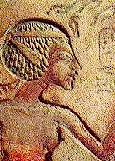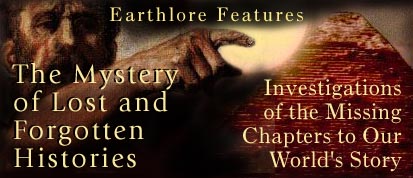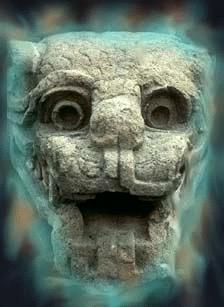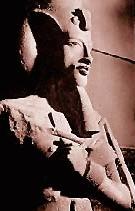
History
tends to be the history of the winners, with the losers assigned the passive,
largely unvoiced, faceless role of the people on whom the winners operated.
—M. I. Finley |

We reached
the deep-flowing ocean where the Cimmerians have their lands and their town.
This people is hidden under clouds, in mists that the sun's bright rays have
never pierced.
—Homer, Odyssey |

In the
sixth regnal year the worship of the Aton was established as the religion of
the state. Henceforth not only the Egyptian but the subject Nubians and Asiatics
as well were to serve this one god alone. The temples of the other divinities
were everywhere closed and their property seized. Whoever bore a name compounded
with that of Amun was obliged to change it, and the king himself was among the
first to do so.
—George
Steindorff,
Akhnaton and the Reformation |

For a thousand years it was believed
that the legends of the buried cities of Pompeii and Herculaneum were myths:
they were spoken of as "the fabulous cities."
For a thousand years the educated world did not credit the accounts given by
Herodotus of the wonders of the ancient civilizations of the Nile and of Chaldea.
He was called "the father of liars." Even Plutarch sneered at him.
Now, in the language of Frederick Schlegel, "the deeper and more comprehensive
the researches of the moderns have been, the more their regard and esteem for
Herodotus has increased."
—Ignatius Donnelly |
| |
So all day long the
noise of battle roll'd
Among the mountains by the winter sea;
Until King Arthur's Table, man by man,
Had fallen in Lyonesse about their
lord,
King Arthur . . .
- Tennyson, Idylls
of the King
 It
has long been said, in many languages, that if there is one aspect most universal
about humanity, it is that we are story loving beings. The overwhelming evidence
for this is the vast heritage of mythology, legend and folklore which emanates from
the heart of every culture on earth, dating back to the earliest records of human
history. It
has long been said, in many languages, that if there is one aspect most universal
about humanity, it is that we are story loving beings. The overwhelming evidence
for this is the vast heritage of mythology, legend and folklore which emanates from
the heart of every culture on earth, dating back to the earliest records of human
history.
 That
which makes us unique however, is our personal preference in story. We each
loan our imagination to certain tales over others. The reasons for our distinct
tastes are very often, not consciously known to us. In time, we learn that there
is no wrong choice, when we follow, in faith, that which captures our heart. That
which makes us unique however, is our personal preference in story. We each
loan our imagination to certain tales over others. The reasons for our distinct
tastes are very often, not consciously known to us. In time, we learn that there
is no wrong choice, when we follow, in faith, that which captures our heart.
"Papa,
mira toros pintados!"
("Papa, look at the painted bulls!")
—Maria (at 12), daughter of Don Marcelino Sanz de
Sautuola,
First explorer (after Maria) of the caves at Altamira, 1879 |
 If
Life itself, is like any one type of story, it is most like a Mystery. Within
the many cycles of existence can be found comedies, love stories, If
Life itself, is like any one type of story, it is most like a Mystery. Within
the many cycles of existence can be found comedies, love stories,  tragedies
and adventures. Yet, at the center of each, and very often, at the finish, we find
pervasive mystery. tragedies
and adventures. Yet, at the center of each, and very often, at the finish, we find
pervasive mystery.
 Far
back into prehistory, the earliest forms of religion, the world over, revered
and celebrated this mysterious aspect of life. Even today, we still refer to these
early beliefs as the Mystery religions. Rituals often included the reenactment
of scenes from myth involving a hero's interaction with the forces of life. The
stance of participants within such rituals was not to fear, but rather, to inhabit
the mystery. Far
back into prehistory, the earliest forms of religion, the world over, revered
and celebrated this mysterious aspect of life. Even today, we still refer to these
early beliefs as the Mystery religions. Rituals often included the reenactment
of scenes from myth involving a hero's interaction with the forces of life. The
stance of participants within such rituals was not to fear, but rather, to inhabit
the mystery.
| Image above:
Mural of Eleusinian mystery rite, depicting the goddess Demeter with her
daughter Persephone. Eleusis, Greece, 5th century BCE. |
| View
the Foundation Stone of Learning about the Eleusinian
Mysteries |
 Today,
we seldom worship the mysterious. Still, we are drawn toward and often mesmerized
by that which is beyond the reach of our knowledge and understanding. We all,
love a good Mystery! It doesn't necessarily need to be fiction, either. There is
much about the real world which remains to be conclusively explained.
The lure of this unknown inspires each generation on to further exploration and
revelation. New discoveries are made continuously in archaeology, genetics and a
range of other fields. Today,
we seldom worship the mysterious. Still, we are drawn toward and often mesmerized
by that which is beyond the reach of our knowledge and understanding. We all,
love a good Mystery! It doesn't necessarily need to be fiction, either. There is
much about the real world which remains to be conclusively explained.
The lure of this unknown inspires each generation on to further exploration and
revelation. New discoveries are made continuously in archaeology, genetics and a
range of other fields.
"The
work of the spade has now brought out the essential underlying truth of the
old traditions that made Knossos the most ancient culture of civilized life
in Greece and with it, of our whole continent. No equal plot of Earth's surface
has been as productive in such various directions of so many unique records
bearing on our earliest culture."
—Sir Arthur J. Evans, English Archaeologist,
relating the advances of 40 years of discoveries on Crete. |

The ancient city of Petra; carved into the living
stone cliffs of Jordan. |
 There
is no doubt that these advances increase the understanding of our world,
and its inhabitants. Yet, paradoxically, they also reveal to us the scale of
ignorance regarding what we know of our own nature and history. At times,
it seems we are only lately beginning to understand who we are, and what our
place is in the Universe. The more we learn, the more we realize how much remains
to yet to be learned. This holds true even though the quest for understanding
has been a devoted pursuit for thousands of years. There
is no doubt that these advances increase the understanding of our world,
and its inhabitants. Yet, paradoxically, they also reveal to us the scale of
ignorance regarding what we know of our own nature and history. At times,
it seems we are only lately beginning to understand who we are, and what our
place is in the Universe. The more we learn, the more we realize how much remains
to yet to be learned. This holds true even though the quest for understanding
has been a devoted pursuit for thousands of years. |
 Every
child approaches life with a desire to know...to learn about the surrounding world.
For each, the legacy of all that has been learned, is perceived anew.
The movement of life is fluid and the landscape of history ever changing, so that
every generation stands upon raw investigative ground. Inspired speculation, tempered
by disciplined study proves to be the key to a broader encounter with the story of
this world and its inhabitants. Every
child approaches life with a desire to know...to learn about the surrounding world.
For each, the legacy of all that has been learned, is perceived anew.
The movement of life is fluid and the landscape of history ever changing, so that
every generation stands upon raw investigative ground. Inspired speculation, tempered
by disciplined study proves to be the key to a broader encounter with the story of
this world and its inhabitants.
 Of
great value to contemporary explorers of history, are the fruits of those who
have passed this way before us. Seeking answers in the past from contemporary perspectives
does not equate to disregarding previous research and discovery. On the contrary,
past efforts are the very foundation for future investigation. However, it is fair
to suggest that along with the discerning analysis of a scholar, serious explorers
maintain the improvisational openness of a curious child as they seek. Of
great value to contemporary explorers of history, are the fruits of those who
have passed this way before us. Seeking answers in the past from contemporary perspectives
does not equate to disregarding previous research and discovery. On the contrary,
past efforts are the very foundation for future investigation. However, it is fair
to suggest that along with the discerning analysis of a scholar, serious explorers
maintain the improvisational openness of a curious child as they seek.
"One
of the most impressive and touching sights I have ever seen was this grand pyramid
bathed in the light of the moon!"
—Sir Eric Thompson, English Archaeologist,
describing the Maya site at Tikal in Guatemala, 1906. |
|






 tragedies
and adventures. Yet, at the center of each, and very often, at the finish, we find
pervasive mystery.
tragedies
and adventures. Yet, at the center of each, and very often, at the finish, we find
pervasive mystery.
 being
put forth on several important chapters of history. Our inspiration
for this series of projects rises from the need for sanity and some
sense of methodical order in this ever evolving process. Is there
any relevance today for verification of a historical King Arthur hidden
in the mists of legend? Are there lessons in studying the decline
of ancient Peruvian civilization? Here, you can decide for yourself.
being
put forth on several important chapters of history. Our inspiration
for this series of projects rises from the need for sanity and some
sense of methodical order in this ever evolving process. Is there
any relevance today for verification of a historical King Arthur hidden
in the mists of legend? Are there lessons in studying the decline
of ancient Peruvian civilization? Here, you can decide for yourself.


 Is
there any historical evidence which validates the assertion of a material
grail? Some say there is. Yet, in approaching such an exploration as the
Grail of Christ, one must enter into the realms of myth, spirituality
and symbol as countless other seekers have done for many centuries.
Is
there any historical evidence which validates the assertion of a material
grail? Some say there is. Yet, in approaching such an exploration as the
Grail of Christ, one must enter into the realms of myth, spirituality
and symbol as countless other seekers have done for many centuries.
